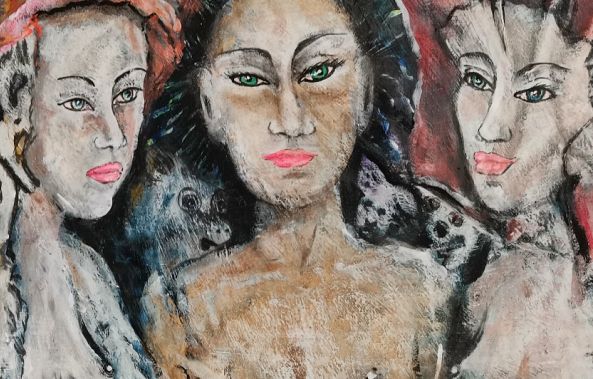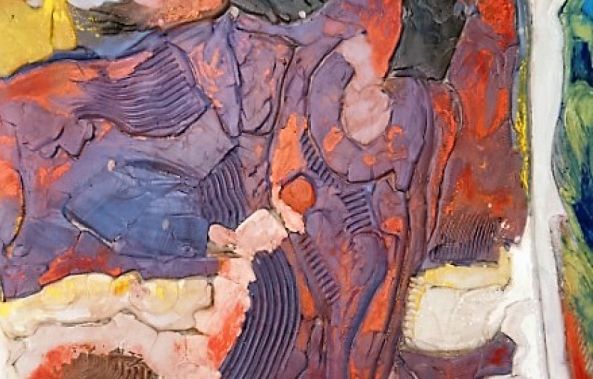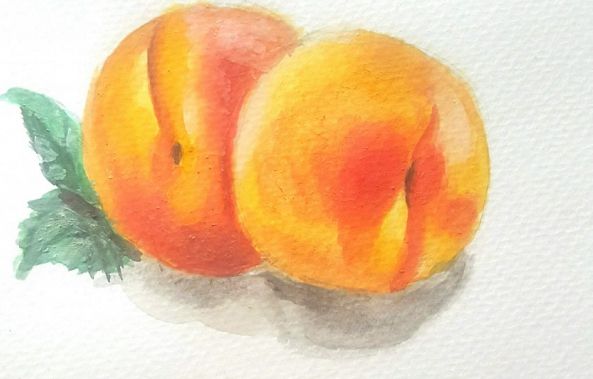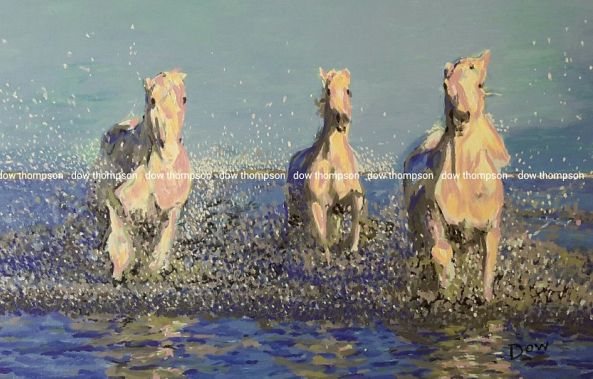Baroque painting: characteristics, techniques, famous artists
Baroque is well known for its extravagance and over-the-top style, and is still a familiar sight in many European cathedrals and palaces. The term can be applied to architecture, music, and art, and there are many recognizable examples of each. It began as a Catholic reaction to the conservative style of Protestant religious buildings, and visual excess was actively encouraged.
The word baroque is a French word of Portuguese origin, and means “a pearl of irregular shape.” It was originally used as a negative term in 1855 to describe the art movement, which the art historian Jacob Burchhardt saw as a subversion of the values of the Renaissance movement. It gradually lost its negative meaning, and became the name for this period of art history.
Baroque art period

Image via http://www.oeuvres-art.com
The Baroque period is largely regarded as lasting from the early 17th century until the late 18th century, and there were artists active in many European cities. It was particularly popular in Rome, where it started, and other European countries such as France, Germany, Spain, and Holland. It came immediately after the Renaissance period as a counteraction to the simplicity of Protestant architecture after the Reformation.
The Reformation encouraged simple, inelegant religious buildings that were designed to appeal to scholars and intellects but weren’t popular among regular churchgoers. The Catholic Church decided to design their religious spaces with mass appeal, and believed the arts were a form of religious expression that should be celebrated. The baroque art style gradually grew out of these original decisions as more emphasis was placed on the enjoyment of splendor.
Some characteristics of Baroque art
The main characteristics of both Baroque art and architecture are the use of contrast, detail, movement, and surprise in order to create a sense of awe in the viewer. The intention was to give viewers something interesting to look at that could keep attention. Artists and architects favored warm colors contrasted against ornate accents of gold. They made use of the three primary colors in close proximity to each other, which created a sense of obviousness and drama.
Because painters and architects usually favored religious or classical scenes, many of their works had a clear story or message behind them. They contrasted dark backgrounds against light characters to create a sense of movement, and to make the viewer see the intended story. These same Baroque characteristics were applied to musical compositions from the time period, which always had a story or message for the audience.
The Baroque movement gradually evolved into the Rococo movement in France and central Europe, and both movements died out in the 18th century. They were followed by the Neo-classical movement, which placed much more emphasis on traditional ideas and techniques. The main difference between Baroque and Rococo is that the latter is much more theatrical. It featured fluid curves and a greater sense of illusion. It also favored white and pastel colors over contrasting dark and light, which ultimately creates a much busier scene.
Baroque architecture and sculpture

Image via wikimedia.org
Religious buildings in the Baroque style are characterized by large, open central spaces with high domes overhead. This allowed natural light in and illuminated the space in a particular way. The dome is a typical symbol of the Baroque period, and it symbolizes the union between Heaven and Earth. The domes are always intricately decorated, often with an intense use of gold accents and paintings. The walls are decorated with incredibly detailed paintings, and there will usually be many statues of angels and other religious figures.
The same general techniques were also applied to sculpture. Sculptures attempted to create a sense of movement, and would usually have figures centered on a vortex (an empty space in the middle). One of the most famous Baroque sculptors is Gian Lorenzo Bernini, who has work all over Italy and central Europe. Just as with paintings and architecture, the sculptures were designed to tell a story, which was usually religious or classical.
Baroque music and ballet

Image via http://www.luigiboccherini.org
The Baroque time period saw a massive explosion in musical expression, and even led to the creation of several new musical styles, including the concerto and sinfonia. It also coincided with the invention of the Opera, which took off during the 17th century. The concept of common-practice tonality was also invented during the Baroque period. It’s the idea of writing music in a certain key, and is still widely used to this day. Many of history’s most famous composers were around during the Baroque movement, including Antonio Vivaldi, Johann Sebastian Bach, and George Frideric Handel.
Ballet was also born during this period, when a new style of court dance was introduced to France. Louis XIV was a massive fan, and just as with many things a king finds popular, it took off quickly. Once actual performances started, it soon became much more intricate and became the ballet we know today.
Baroque Paintings

Image via https://commons.wikimedia.org
Baroque-style paintings incorporates a wide number of individual styles and artists, but they all share common features, and all occur in the general Baroque period. The paintings focus on creating a sense of drama, and use rich, deep colors contrasted against dark backgrounds. Unlike Renaissance art, which usually depicted the moment before an event, Baroque art chooses the most dramatic point and focuses on it intensely. It was intended to evoke passion and emotion in the viewer, which was a conscious decision made by the Catholic Church in the late 16th century.
There were stylistic variations in the countries that adopted Baroque art. Much of central Europe produced painters and architects that used the style, but local influences can be seen in many works of art. For example, Dutch painters focused less on religious or historical scenes, and more on secular subjects such as still life and landscape. While famous Dutch painters such as Vermeer and Rembrandt clearly adopt the Baroque style, they show other influences too.
Baroque art characteristics
• Intense sense of drama
• Painting often tells a story or gives message
• Traditionally depicts religious or classical scenes
• Rich, deep colors, often contrasting the three primaries
• Light subjects against dark backgrounds
Renaissance art vs. Baroque art

Image via http://www.baroquemusic.org
One of the main principles of Renaissance art was that of stability. Even when paintings depicted a scene, much of it was very still. They would use recognizable shapes to structure their work as this would help create a sense of stability for the viewer. Baroque artists instead used angled lines to create a sense of drama and movement, often putting subjects in opposing positions to heighten the tension.
In Renaissance art, the painter would always develop a full background for their painting, even if it wasn’t particularly detailed. The background was considered as important as the subject, and added to the idea of stability. If a subject was sat against a still background, the viewer can tell they’re still. In Baroque paintings, the background is usually just blacked out. Whether this was because the painters considered them unimportant or not, it certainly highlighted whatever was the subject of the painting. These rules for Baroque style paintings do vary however, and most countries had their own established version of the style.
Baroque painters
Different countries experimented with the basic concepts of Baroque art, and brought in influences from other disciplines and art styles. Painters from traditionally Catholic countries, such as France and Italy, stuck to the conventions of the style but evolved their use of color and drama. One the other hand, painters from countries with a lower Catholic population, such as Holland and England, continued to experiment with other styles of art, and incorporated them into their Baroque paintings.
Dutch Baroque artists
Rembrandt (1606-1669)

Image via http://www.latimes.com
Rembrandt is one of the most famous artists of the Dutch Golden Age, and he painted a wide variety of different subjects. He painted many Biblical and mythological scenes and used Baroque techniques of contrast and movement. Although he isn’t considered a Baroque artist by all art historians, he definitely used many of the techniques and styles in his art.
Johannes Vermeer (1632-1675)
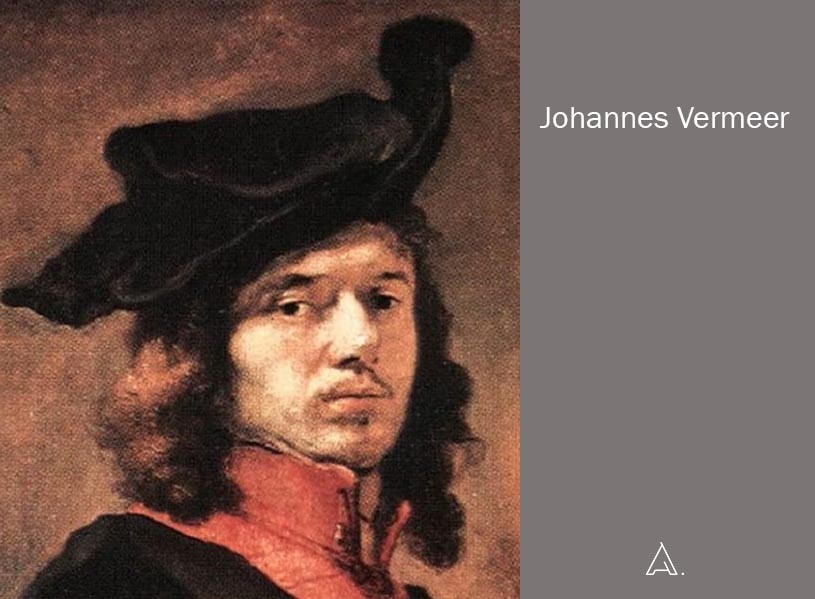
Image via https://www.rivagedeboheme.fr
Vermeer is one of the greatest painters of the 17th century, and devoted his entire life to his work. Much like Rembrandt, Vermeer isn’t necessarily considered a Baroque painter, mainly due to the lack of idealization in his work. One area of his work that can certainly be regarded as Baroque is his use of expensive pigments in his paintings. He enjoyed using lapis lazuli, which is an incredibly expensive blue pigment, and could be considered a Baroque touch to his secular paintings.
Gerard van Honthorst (1592-1656)
.jpg)
Image via https://commons.wikimedia.org
Honthorst was another Dutch Golden Age painter, and Baroque influences can clearly be seen in his work. He painted in Italy for several years at the beginning of his career, and this is likely where the Baroque influence comes from. He makes use of color and movement to create visual drama, and many of his paintings tell a story. He is praised for his depiction of artificially lit scenes, which ties into the Baroque painting characteristic of contrasting light and shade.
Flemish Baroque artists
Peter Paul Rubens (1577-1640)

Image via http://www.visitflanders.com/
Rubens was one of the pioneers of the Flemish Baroque movement, which is characterized by its particular use of light and composition. Rubens studied in Italy, where he was influenced by classical works, and by contemporary artists. During his career he made Antwerp one of the artistic centers of Europe, and is credited with painting over 1400 works! He particularly enjoyed historic scenes, and was also commissioned to design tapestries and prints.
Anthony van Dyck (1599-1641)
Van Dyck became the leading court painters in England, and his style had a massive impact on English artists for well over a century. He travelled around Italy, where he was influenced by contemporary painters, and adopted the Baroque style of drama and contrast. He painted in the Flemish Baroque style, which featured more muted color palettes and secular subjects. That said, he also painted religious and historical scenes.
Frans Snyders (1579-1657)
Snyders was another artist who helped put Antwerp on the cultural map, and regularly collaborated with other Flemish masters. He was well known for painting landscapes, flowers, animals, and still lifes. He adopted the Baroque style of drama and narrative in his work, but often leaned towards muted colors with contrasting flashes of brightness.
French Baroque artists
Nicolas Poussin (1594-1665)
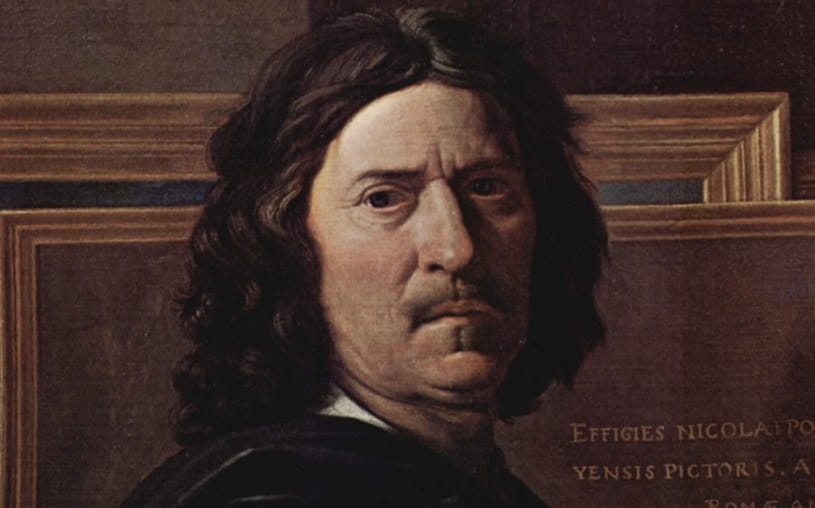
Image via wikimedia.org
Poussin continued to bring in elements of Renaissance artists, and moved away from the conventions of typical Baroque era art paintings. He focused on the idea of work being cerebral, and to create a sense of perfection instead of favoring color. His paintings still included scenes of drama and contrast, but it was done in a more classical style.
Hyacinthe Rigaud (1659-1743)
Rigaud is most famous for his portraits of French king Louis XIV and other members of nobility. He used the Baroque style to expertly capture the sense of grandeur in his subjects, and contrasted their colorful outfits against dark backgrounds. His style is typically Baroque by its very nature due to the people he was painting. They were mostly the pioneers of Baroque fashion and ideology.
Italian Baroque artists
Caravaggio (1571-1610)

Image via http://www.bbc.com/
Although technically before the Baroque movement, his work had such a massive influence on the style that Caravaggio is often credited as one of the pioneers. He made dramatic use of light and shadow, and had a keen eye for depicting the moment of greatest drama. His work often features scenes of struggle, torture, and death. His influence can be seen in the work of Rubens, Bernini, Rembrandt, and more.
Artemisia Gentileschi (1593-1656)
Gentileschi was considered one of the most accomplished painters of the Baroque movement, and worked in a time when female painters were often disregarded. Most of her work features scenes of female suffering from Biblical and mythological stories. She made typically Baroque use of light and shade, and was able to inject drama into much of her work.
Spanish Baroque artists
Jose Claudio Antolinez (1636-1675)

Image via wikimedia.org
Antolinez lived his entire life in Madrid, and is one of the most famous members of the Spanish Baroque movement. He painted many different portraits and scenes, and is credited to painting a chapel too. His religious works are very dramatic, and he uses Baroque color palettes of primary colors against dark backgrounds.
Francisco Ribalta (1565-1628)
Ribalta worked in Madrid and Valencia, mainly painting religious subjects. He painted his figures in typically dark and gloomy scenes, with very dark backgrounds and bold pops of color. He was one of the first Spanish artists to adopt Caravaggio’s style of Baroque painting.
Famous Baroque paintings
 Image via https://commons.wikimedia.org |
 Image via http://www.abcgallery.com |
 Image via https://commons.wikimedia.org |
| Allegory of War Jan Brueghel the Younger |
David and Uriah Rembrandt (1665) |
Dedication of a New Vestal Virgin Alessandro Marchesini (1710s) |
 Image via https://pixels.com/ |
 Image via https://www.wikiart.org |
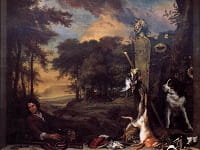 Image via https://commons.wikimedia.org |
| The Flagellation of Christ Caravaggio (1609) |
Judith and her Maidservant Artemisia Gentileschi (1612-1613) |
Landscape with a Huntsman and Dead Game Jan Weenix (1697) |
The end of Baroque
Just as with any art style or movement, Baroque gradually began to lose popularity during the 18th century. Madame de Pompadour, the mistress of French king Louis XV may have indirectly contributed to its decline across Europe. She sent several artists and sculptors to Italy to study artistic styles and fashions. They returned from their trip with a love for classical styles and techniques, which eventually gave rise to Neo-classicism. By the 19th century Baroque was regarded as old fashioned and gaudy, with many contemporary critics slamming the art movement.
However, the Baroque style grew in popularity again during the 20th century, and it has remained reasonably popular ever since. This doesn’t mean we’re going to get a wave of new Baroque buildings, but it does mean we can show a greater appreciation for the surviving examples of this intricate style.

